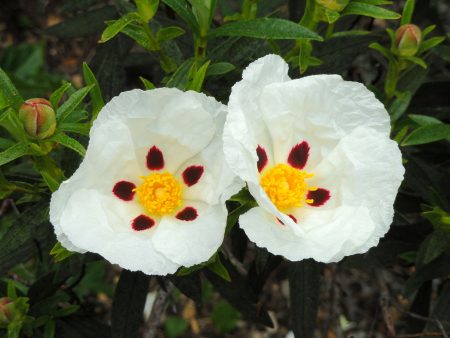
Labdanum via wiki
There would be no perfume without labdanum.
That may be a bit dramatic… but at the very least, a large part of the olfactive art would be missing.
Labdanum is one of the oldest known aromatics throughout history. With appearances in the Bible, ancient Egypt, the pharmacy, and even some liquors. It’s responsible for the transcendent sweet-resinous-balsamic aroma that marks the base of many perfumes, both indie and commercial alike. It’s become a hallmark to the family of scent known as “amber”.
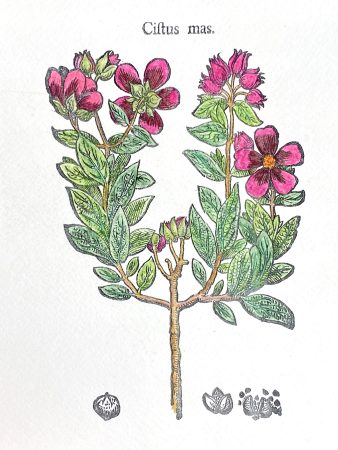
Cistus painting used with permission from Mandy Aftel of Aftelier Perfumes© who painted beautiful cistus plants based on her antique B&W engravings from her 300-year-old botanical books
The resin of labdanum comes from a low-lying shrub Cistus ladinifer that thrives in rocky outcrops along the Mediterranean coast. It’s also known as Rock Rose, named for the 5-petaled white flowers that look akin to the common tea rose. But it’s not the flowers that give us the scent of Labdanum… for that, we turn to goats. Legend has it, that it was Arabian goat farmers that mistakenly discovered this sticky aromatic resin. In the heat of the noon sun, the cistus plant excretes a resinous, thick sap from its leaves and branches (thought to protect the plant from losing moisture).
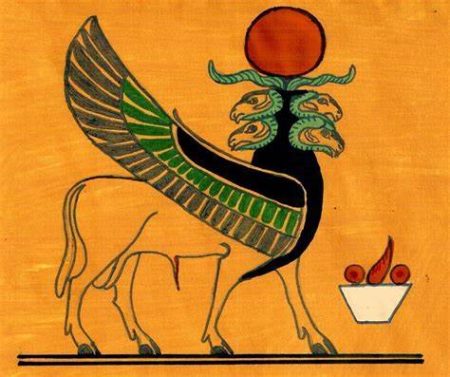
Banebdjedet of Mendes Illustration of the god Banebdjedet or Banebdjed (“Ba of the Lord of Mendes”) depicted with four rams’ heads. He was the ba of Ra, Shu, Geb and Osiris. via wiki art
When grazing goats came to snack upon the cistus bush, their furs would become saturated in this thick, amber-like sap… much to the dismay of the farmers, who were responsible for cleaning it out. But, this is where something historic happens – As the farmers attempted to comb these clumps of sticky mass out of their goats furs, they noticed it’s pleasing, persistent sweet aroma. Goats are notoriously smelly beasts by nature, so this must have seemed of divine origin.
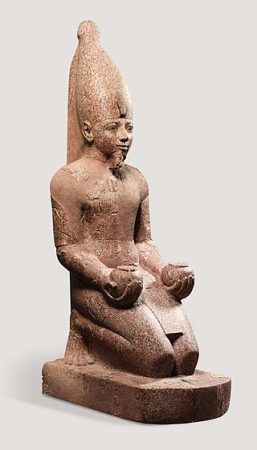
Queen Hatshepsut depicted as a King with the White crown of Upper Egypt and labdanum beard/ Wikimedia commons via public domain
And indeed, it was. In Ancient Egypt, labdanum was held as sacred; thought to have been created from the “Tears of Osiris “, which fell from the heavens on to the cistus bush, to create this aromatic resin. Pharaohs of the time were seen wearing faux-beards of braided goat furs, soaked in labdanum, as a symbol of leadership and connection to the heavens (as first argued by Egyptian Scholar Percy E. Newberry )
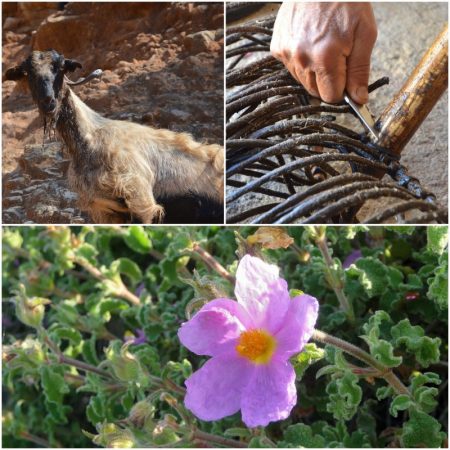
Clockwise: Cretan goat covered with labdanum resin, ladanisterion tool, and Cistus Creticus in bloom (Photos: essentialreflections.com)©
And the goats? They were celebrated as the manifestations of an Osirian deity known as “Ram of Mendes.” Thus, a new commodity was born. At first, goat farmers began raking the sticky resin from the goats using crude leather combs, or simply shaving their goats altogether and selling their resin-saturated hair throughout the Mediterranean. Harvesting practices soon evolved to include something known as lambadistrion – a whip-like device with two rows of many leather strips. These were swept over the cistus bushes to collect the sticky resins. It’s not as common, but a few small farms still use tools that resemble this ancient original. Today, labdanum is widely collected without the help of goats. It’s primarily harvested by cutting the entire bush and submerging the leaves and branches in boiling water, causing the sticky resins to float to the top. This gives us the a grade of crude labdanum resin, sometimes called an “oleoresin” or “gum”.
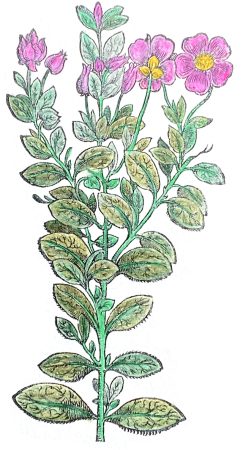
Cistus painting used with permission from Mandy Aftel of Aftelier Perfumes© who painted beautiful cistus plants based on her antique B&W engravings from her 300-year-old botanical books
Taking that crude resin and furthering refined via solvent extraction will yield labdanum absolute; a golden-amber, very sticky, substance with a consistency like that of honey. Its aroma is incredibly rich, resinous, sweet-balsamic with nuances of ambergris and hints of wood. Very potent and used though numerous formulas, across almost all genres – but most notoriously in amber-type perfumes. Steam distillation of the crude resin will result in a whole new material; know as “Cistus”. While similar in tone to Labdanum, Cistus is really its own little world – it’s brighter, louder and more fruity-balsamic with a dry-woody note as it dies down. When added to a forest or amber blend, it has an incredibly ability to breathe air into a composition, as if lifting and expanding from the bottom up. If labdanum is the “Bass”, then Cistus is more like an “Alto”, or even “Soprano”.
Today, Labdanum, even has a place on WebMD, where it can be found as a treatment for a host of ailments, including lung infections (bronchitis), Diarrhea, edema and menstrual problems. This is due to the powerful cocktail of substances within Labdanum’s chemistry (mainly sesquiterpenes); which are thought to stop viruses from attacking human cells.
From the bellies of goats, to the chins of pharaohs and back to the pharmacy- we have a lot to thank this sticky aromatic resin for.
So, thank you labdanum- the champion of perfume.
Mason Hainey, Guest Contributor and Natural Perfumer for MIZU
Art direction: Michelyn Camen, Editor-in-Chief
For our Labdanum in Perfumery draw
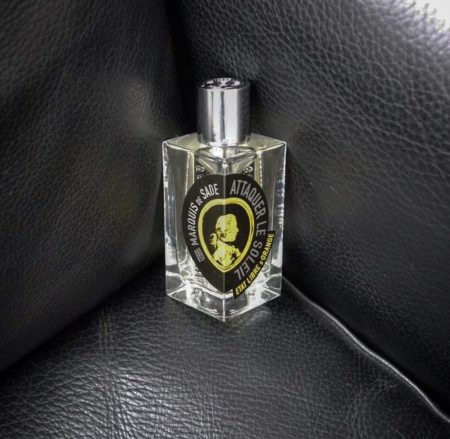
Attaquer le Soleil Marquis de Sade display courtesy of the brand
Big Merci to Etat Libre D’Orange we have 50 ml Attaquez le Soleil by Quentin Bisch (who abhors labdanum and cistus, so he forced himself to build the perfume around this single cistus ingredient (read Lauryn’s review here) for a registered reader in the USA, UK, EU and Canada
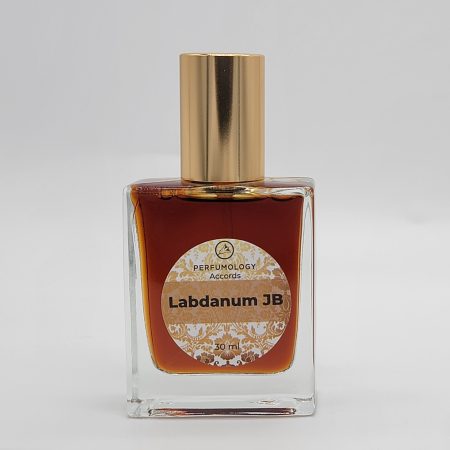
Photo by Perfumology
Thanks to Perfumology for Labdanum JB (composed by John Biebel of January Scent Project) for a registered reader in the USA only
To be eligible please leave a comment with what you learned about Labdanum in Perfumery, which you would like to win and where you live. The draw is for registered readers only, so be sure to register if you have not done so. Draw closes 6/21/2022
Follow us @cafleurebonofficial @mizubrand @etatlibredorange @quentinbisch @perfumology @januaryscentproject and @aftelierperfumes
We announce the winners only on site and on our Facebook page, so Like ÇaFleureBon and use our Blog feed…or your dream prize will be just spilled perfume
This is our Privacy and Draw Rules Policy
